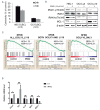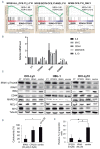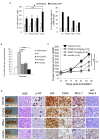Interleukin-1 receptor associated kinase 1/4 and bromodomain and extra-terminal inhibitions converge on NF-κB blockade and display synergistic antitumoral activity in activated B-cell subset of diffuse large B-cell lymphoma with MYD88 L265P mutation
- PMID: 33979991
- PMCID: PMC8485659
- DOI: 10.3324/haematol.2020.278258
Interleukin-1 receptor associated kinase 1/4 and bromodomain and extra-terminal inhibitions converge on NF-κB blockade and display synergistic antitumoral activity in activated B-cell subset of diffuse large B-cell lymphoma with MYD88 L265P mutation
Erratum in
-
Interleukin-1 receptor associated kinase 1/4 and bromodomain and extra-terminal inhibitions converge on NF-κB blockade and display synergistic antitumoral activity in activated B-cell subset of diffuse large B-cell lymphoma with MYD88 L265P mutation.Haematologica. 2022 Dec 1;107(12):2990. doi: 10.3324/haematol.2022.281988. Haematologica. 2022. PMID: 36453521 Free PMC article. No abstract available.
Figures



Similar articles
-
Oncogenically active MYD88 mutations in human lymphoma.Nature. 2011 Feb 3;470(7332):115-9. doi: 10.1038/nature09671. Epub 2010 Dec 22. Nature. 2011. PMID: 21179087 Free PMC article.
-
Interleukin-1 receptor associated kinase 1/4 and bromodomain and extra-terminal inhibitions converge on NF-κB blockade and display synergistic antitumoral activity in activated B-cell subset of diffuse large B-cell lymphoma with MYD88 L265P mutation.Haematologica. 2022 Dec 1;107(12):2990. doi: 10.3324/haematol.2022.281988. Haematologica. 2022. PMID: 36453521 Free PMC article. No abstract available.
-
A mutation in MYD88 (L265P) supports the survival of lymphoplasmacytic cells by activation of Bruton tyrosine kinase in Waldenström macroglobulinemia.Blood. 2013 Aug 15;122(7):1222-32. doi: 10.1182/blood-2012-12-475111. Epub 2013 Jul 8. Blood. 2013. PMID: 23836557
-
[MyD88 L265P mutation and B cell tumor].Zhongguo Shi Yan Xue Ye Xue Za Zhi. 2014 Feb;22(1):241-4. doi: 10.7534/j.issn.1009-2137.2014.01.048. Zhongguo Shi Yan Xue Ye Xue Za Zhi. 2014. PMID: 24598687 Review. Chinese.
-
MYD88 L265P Mutation in Lymphoid Malignancies.Cancer Res. 2018 May 15;78(10):2457-2462. doi: 10.1158/0008-5472.CAN-18-0215. Epub 2018 Apr 27. Cancer Res. 2018. PMID: 29703722 Review.
Cited by
-
G protein-coupled receptor 183 mediates the sensitization of Burkitt lymphoma tumors to CD47 immune checkpoint blockade by anti-CD20/PI3Kδi dual therapy.Front Immunol. 2023 Apr 21;14:1130052. doi: 10.3389/fimmu.2023.1130052. eCollection 2023. Front Immunol. 2023. PMID: 37153563 Free PMC article.
-
YPEL2 regulates the efficacy of BRD4-EZH2 dual targeting in EZH2Y641mut germinal center-derived lymphoma.Neoplasia. 2025 Mar;61:101131. doi: 10.1016/j.neo.2025.101131. Epub 2025 Feb 5. Neoplasia. 2025. PMID: 39914169 Free PMC article.
References
-
- Pasqualucci L. Molecular pathogenesis of germinal center-derived B cell lymphomas. Immunol Rev. 2019;288(1):240-261. - PubMed
Publication types
MeSH terms
Substances
LinkOut - more resources
Full Text Sources
Other Literature Sources

